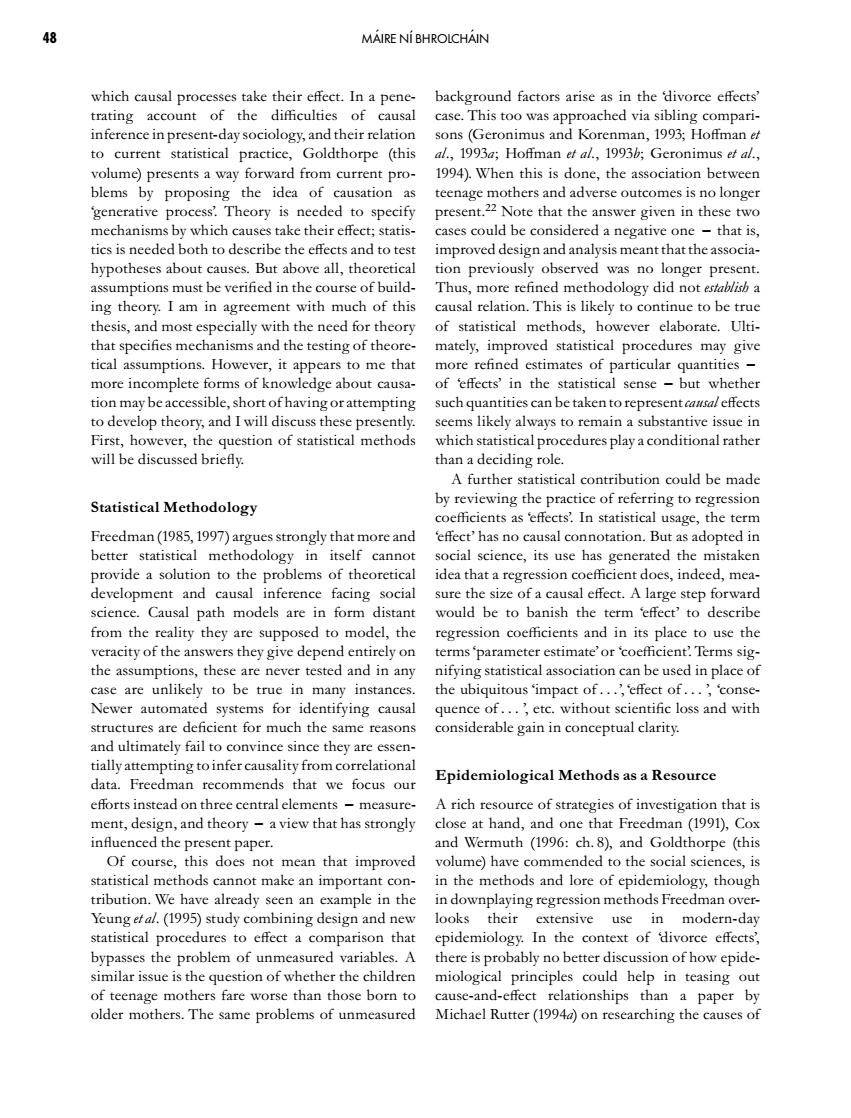正在加载图片...

48 MAIRE NI BHROLCHAIN which causal processes take their effect.In a pene- background factors arise as in the divorce effects' trating account of the difficulties of causal case.This too was approached via sibling compari- inference in present-day sociology,and their relation sons(Geronimus and Korenman,1993;Hoffman ef to current statistical practice,Goldthorpe (this al.,1993a;Hoffman ef al.,1993b;Geronimus ef al., volume)presents a way forward from current pro- 1994).When this is done,the association between blems by proposing the idea of causation as teenage mothers and adverse outcomes is no longer generative process.Theory is needed to specify present.22 Note that the answer given in these two mechanisms by which causes take their effect;statis- cases could be considered a negative one -that is, tics is needed both to describe the effects and to test improved design and analysis meant that the associa- hypotheses about causes.But above all,theoretical tion previously observed was no longer present. assumptions must be verified in the course of build-Thus,more refined methodology did not establish a ing theory.I am in agreement with much of this causal relation.This is likely to continue to be true thesis,and most especially with the need for theory of statistical methods,however elaborate.Ulti- that specifies mechanisms and the testing of theore-mately,improved statistical procedures may give tical assumptions.However,it appears to me that more refined estimates of particular quantities more incomplete forms of knowledge about causa- of 'effects'in the statistical sense -but whether tion may be accessible,short of having or attempting such quantities can be taken to represent caural effects to develop theory,and I will discuss these presently. seems likely always to remain a substantive issue in First,however,the question of statistical methods which statistical procedures play a conditional rather will be discussed briefly. than a deciding role. A further statistical contribution could be made Statistical Methodology by reviewing the practice of referring to regression coefficients as 'effects.In statistical usage,the term Freedman(1985,1997)argues strongly that more and 'effect'has no causal connotation.But as adopted in better statistical methodology in itself cannot social science,its use has generated the mistaken provide a solution to the problems of theoretical idea that a regression coefficient does,indeed,mea- development and causal inference facing social sure the size of a causal effect.A large step forward science.Causal path models are in form distant would be to banish the term 'effect'to describe from the reality they are supposed to model,the regression coefficients and in its place to use the veracity of the answers they give depend entirely on terms'parameter estimate'or 'coefficient.Terms sig- the assumptions,these are never tested and in any nifying statistical association can be used in place of case are unlikely to be true in many instances. the ubiquitous'impact of...,effect of...','conse- Newer automated systems for identifying causal quence of...',etc.without scientific loss and with structures are deficient for much the same reasons considerable gain in conceptual clarity. and ultimately fail to convince since they are essen- tially attempting to infer causality from correlational data.Freedman recommends that we focus our Epidemiological Methods as a Resource efforts instead on three central elements -measure- A rich resource of strategies of investigation that is ment,design,and theory -a view that has strongly close at hand,and one that Freedman (1991),Cox influenced the present paper. and Wermuth (1996:ch.8),and Goldthorpe (this Of course,this does not mean that improved volume)have commended to the social sciences,is statistical methods cannot make an important con-in the methods and lore of epidemiology,though tribution.We have already seen an example in the in downplaying regression methods Freedman over- Yeung efal.(1995)study combining design and new looks their extensive use in modern-day statistical procedures to effect a comparison that epidemiology.In the context of divorce effects' bypasses the problem of unmeasured variables.A there is probably no better discussion of how epide- similar issue is the question of whether the children miological principles could help in teasing out of teenage mothers fare worse than those born to cause-and-effect relationships than a paper by older mothers.The same problems of unmeasured Michael Rutter(19940)on researching the causes of
"
3 !
G
K
#
*
2
4 5
"
3 (
3
7
!
$
"
!
F
B
"
F #%&'-%&&.*
)
"
<
F
3
>
>
B
1
" ?
,
#%&&-*
3
+
5
"
2 3
4
5
#K
%&&=( $3
%&&=( $3
%&&=
( K
%&&C* ?
99 <
>
5
5
"
> 23
4
>
"
3
"
+
G
23
4 !
23 4
7
"
G
0
3 +
23 4
G
2
4 2G 4 5
2 423 4 2
4
6
"
7
+
F #%&&%* ) ?
#%&&EA
'* K
#
*
F "
!
2 3
4
3
6
I #%&&C*
�����������������������������������������������������������������������������������������������������������������������������������������������������������������������������������������������������������������������������������������������������������������������������������������������������������������������������������